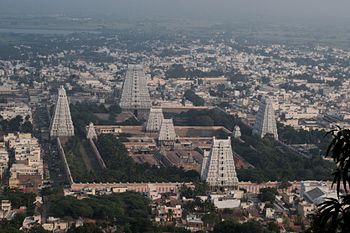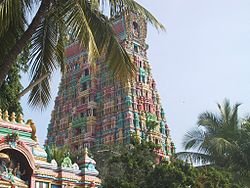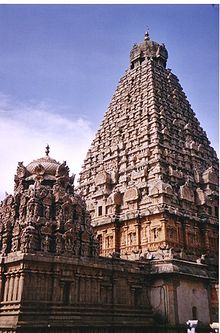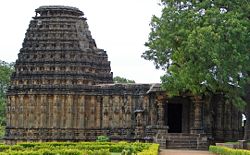- Dravidian architecture
-
Dravidian architecture was a style of architecture that emerged thousands of years ago in Southern part of the Indian subcontinent or South India. They consist primarily of pyramid shaped temples called Koils which are dependent on intricate carved stone in order to create a step design consisting of many statues of deities, warriors, kings, and dancers. The majority of the existing buildings are located in the Southern Indian states of Tamil Nadu, Andhra Pradesh, Kerala, and Karnataka. Various kingdoms and empires such as the Pallavas, Cholas, Pandyan, Chera, Chalukyas, Rashtrakutas, Hoysalas, Vijayanagara Empire amongst the many others have made a substantial contribution to the evolution of Dravidian architecture through the ages. Dravidian styled architecture can also be found in parts of Northeastern Sri Lanka, Maldives, and various parts of Southeast Asia.
Contents
Composition and structure
 The Meenakshi temple complex of Madurai
The Meenakshi temple complex of Madurai
Dravidian style temples consist almost invariably of the four following parts, arranged in differing manners, but differing in themselves only according to the age in which they were executed:[1]
- The principal part, the temple itself, is called the Vimanam. It is always square in plan and surmounted by a pyramidal roof of one or more stories; it contains the cell where the image of the god or his emblem is placed.
- The porches or Mantapams, which always cover and precede the door leading to the cell.
- Gate-pyramids, Gopurams, which are the principal features in the quadrangular enclosures that surround the more notable temples.
- Pillard halls (Chaultris or Chawadis) are used for many purposes and are the invariable accompaniments of these temples.
Besides these, a temple always contains tanks or wells for water – to be used for sacred purposes or the convenience of the priests – dwellings for all the grades of the priesthood are attached to it, and other buildings for state or convenience.[1]
Influence from different periods
In Southern India seven kingdoms and empires stamped their influence on architecture during different times.:
Sangam period
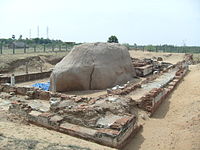 The Subrahmanya Murugan temple of Saluvankuppam, in Saluvankuppam near Mahabalipuram in Tamil Nadu. The brick shrine dates to the Sangam period and is one of the oldest Hindu temples to be unearthed
The Subrahmanya Murugan temple of Saluvankuppam, in Saluvankuppam near Mahabalipuram in Tamil Nadu. The brick shrine dates to the Sangam period and is one of the oldest Hindu temples to be unearthed
From 1000BCE-300CE, the greatest accomplishments of the kingdoms of the early Chola, Chera and the Pandyan kingdoms included brick shrines to deities Murugan, Shiva, Amman and Thirumal (Vishnu) of the Tamil pantheon. Some were built Several of these have been unearthed near Adichanallur, Kaveripoompuharpattinam and Mahabalipuram, and the construction plans of these sites of worship were shared to some detail in various poems of Sangam literature. One such temple, the Saluvannkuppan Murukan temple, unearthed in 2005, consists of three layers. The lowest layer, consisting of a brick shrine, is one of the oldest of its kind in South India, and is the oldest shrine found dedicated to Murukan. It is one of only two brick shrine pre Pallava Hindu temples to be found in the state, the other being the Veetrirundha Perumal Temple at Veppathur dedicated to Vishnu. The dynasties of early medieval Tamilakkam expanded and erected structural additions to many of these brick shrines. Sculptures of erotic art, nature and deities from the Madurai Meenakshi Amman Temple, Chidambaram Thillai Nataraja Temple and the Srirangam Ranganathaswamy Temple date from the Sangam period.
Pallavas
The Pallavas ruled from AD (600–900) and their greatest constructed accomplishments are the single rock temples in Mahabalipuram and their capital Kanchipuram, now located in Tamilnadu.
Pallavas were pioneers of south Indian architecture. The earliest examples of temples in the Dravidian style belong to the Pallava period. The earliest examples of Pallava constructions are rock-cut temples dating from 610 – 690 CE and structural temples between 690 – 900 CE. The greatest accomplishments of the Pallava architecture are the rock-cut temples at Mahabalipuram. There are excavated pillared halls and monolithic shrines known as rathas in Mahabalipuram. Early temples were mostly dedicated to Shiva. The Kailasanatha temple also called Rajasimha Pallaveswaram in Kanchipuram built by Narasimhavarman II also known as Rajasimha is a fine example of the Pallava style temple. Mention must be made here of the Shore Temple constructed by Narasimhavarman II near Mahabalipuram which is a UNESCO World Heritage Site.
Contrary to popular impression about the succeeding empire of the Cholas pioneering in building large temple complexes, it was the Pallavas who actually pioneered not only in making large temples after starting construction of rock cut temples without using mortar, bricks etc.(**) The shining examples of such temples are the Thiruppadagam and Thiruooragam temples that have 28 and 35 feet (11 m) high images of Lord Vishnu in his manifestation as Pandavadhoothar and Trivikraman forms of himself. In comparison the Siva Lingams in the Royal Temples of the Cholas at Thanjavur and Gangaikonda Cholapurams are 17 and 18 feet (5.5 m) high. Considering that the Kanchi Kailasanatha Temple built by Rajasimha Pallava was the inspiration for Raja Raja Chola's Brihadeeswara at Thanjavur, it can be safely concluded that the Pallavas were among the first emperors in India to build both large temple complexes and very large deities and idols(**) Many Siva and Vishnu temples at Kanchi built by the great Pallava emperors and indeed their incomparable Rathas and the Arjuna's penance Bas Relief (also called descent of the Ganga) are proposed UNESCO World Heritage Sites. The continuous Chola, Pallava and Pandiyan belt temples (along with those of the Adigaimans near Karur and Namakkal), as well as the Sethupathy temple group between Pudukottai and Rameswaram uniformly represent the pinnacle of the South Indian Style of Architecture that surpasses any other form of architecture prevalent between the Deccan Plateau and Kanniyakumari(**). Needless to add that in the Telugu country the style was more or less uniformly conforming to the South Indian or Dravidian idiom of architecture.(**)
Pandya
The primary landmark of Srivilliputtur is 12-tiered tower structure dedicated to the Lord of Srivilliputtur, known as Vatapatrasayee. The tower of this temple rises 192 feet (59 m) high and is the official symbol of the Government of Tamil Nadu. It is said to have been built by Periyaazhvar, the father-in-law of the Lord, with a purse of gold that he won in debates held in the palace of Pandya King Vallabhadeva. The Government of Tamil Nadu uses this temple tower as part of its symbol.
Cholas
The Chola kings ruled from AD (848–1280) and included Rajaraja Chola I and his son Rajendra Chola who built temples such as the Brihadeshvara Temple of Thanjavur and Brihadeshvara Temple of Gangaikonda Cholapuram, the Airavatesvara Temple of Darasuram and the Sarabeswara (Shiva )Temple, also called the Kampahareswarar Temple at Thirubhuvanam, the last two temples being located near Kumbakonam. The first three among the above four temples are titled Great Living Chola Temples among the UNESCO World Heritage Sites.
The Cholas were prolific temple builders right from the times of the first king Vijayalaya Chola after whom the eclectic chain of Vijayalaya Chozhisvaram temple near Narttamalai exists. These are the earliest specimen of Dravidian temples under the Cholas. His son Aditya I built several temples around the Kanchi and Kumbakonam regions.
Temple building received great impetus from the conquests and the genius of Aditya I Parantaka I, Sundara Chola, Rajaraja Chola and his son Rajendra Chola I. The maturity and grandeur to which the Chola architecture had evolved found expression in the two temples of Tanjavur and Gangaikondacholapuram. In a small portion of the Kaveri belt between Tiruchy-Tanjore-Kumbakonam, at the height of their power, the Cholas have left over 2300 temples, with the Tiruchy-Thanjavur belt itself boasting of more than 1500 temples. The magnificent Siva temple of Thanjavur built by Raja Raja I in 1009 as well as the Brihadisvara Temple of Gangaikonda Cholapuram, completed around 1030, are both fitting memorials to the material and military achievements of the time of the two Chola emperors. The largest and tallest of all Indian temples of its time, the Tanjore Brihadisvara is at the apex of South Indian architecture.[2] In fact, two succeeding Chola kings Raja Raja II and Kulothunga III built the Airavatesvara Temple at Darasuram and the Kampahareswarar Siva Temple at Tribhuvanam respectively, both temples being on the outskirts of Kumbakonam around AD 1160 and AD 1200. All the four temples were built over a period of nearly 200 years reflecting the glory, prosperity and stability under the Chola emperors.
Contrary to popular impression, the Chola emperors patronized and promoted construction of a large number of temples that were spread over most parts of the Chola empire. These include 40 of the 108 Vaishnava Divya Desams out of which 77 are found spread most of South India and others in Andhra and North India(**). In fact, the Sri Ranganathaswamy Temple in Srirangam, which is the biggest temple in India (**) and the Chidambaram Natarajar Temple (though originally built by the Pallavas but possibly seized from the Cholas of the pre-Christian era when they ruled from Kanchi) (**) were two of the most important temples patronized and expanded by the Cholas and from the times of the second Chola King Aditya I, these two temples have been hailed in inscriptions as the tutelary deities of the Chola Kings (**). Of course, the two Brihadisvara Temples at Thanjavur and Gangaikonda Cholapuram as well as the other two Siva temples, namely the Airavatesvara Temple of Darasuram and the Sarabeswara (Shiva )Temple which is also popular as the Kampahareswarar Temple at Thirubhuvanam, both on the outskirts of Kumbakonam were the royal temples of the Cholas to commemorate their innumerable conquests and subjugation of their rivals from other parts of South India, Deccan Ilangai or Sri Lanka and the Narmada-Mahanadi-Gangetic belts(**). But the Chola emperors underlined their non-partisan approach to religious iconography and faith by treating the presiding deities of their other two peerless creations, namely the Ranganathaswamy Temple dedicated to Lord Vishnu at Srirangam and the Nataraja Temple at Chidambaram which actually is home to the twin deities of Siva and Vishnu (as the reclining Govindarajar) to be their 'Kuladheivams' or tutelary (or family) deities(**). The Cholas also preferred to call only these two temples which home their tutelary or family deities as Koil or the 'Temple', which denotes the most important places of worship for them, underlining their eq. The above-named temples are being proposed to be included among the UNESCO World Heritage Sites, which will elevate them to the exacting and exalting standards of the Great Living Chola Temples(**).
The temple of Gangaikondacholapuram, the creation of Rajendra Chola I, was intended to exceed its predecessor in every way. Completed around 1030, only two decades after the temple at Thanjavur and in much the same style, the greater elaboration in its appearance attests the more affluent state of the Chola Empire under Rajendra.[3] This temple has a larger Siva linga than the one at Thanjavur but the Vimana of this temple is smaller in height than the Thanjavur vimana.
The Chola period is also remarkable for its sculptures and bronzes all over the world. Among the existing specimens in museums around the world and in the temples of South India may be seen many fine figures of Siva in various forms, such as Vishnu and his consort Lakshmi, and the Siva saints. Though conforming generally to the iconographic conventions established by long tradition, the sculptors worked with great freedom in the 11th and the 12th centuries to achieve a classic grace and grandeur. The best example of this can be seen in the form of Nataraja the Divine Dancer.[4]
Badami Chalukyas
Main article: Badami Chalukya Architecture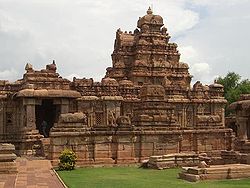 Virupaksha temple, Pattadakal, Karnataka built in 740
Virupaksha temple, Pattadakal, Karnataka built in 740
The Badami Chalukyas also called the Early Chalukyas, ruled from Badami, Karnataka in the period AD 543 – 753 and spawned the Vesara style called Badami Chalukya Architecture. The finest examples of their art are seen in Pattadakal, Aihole and Badami in northern Karnataka. Over 150 temples remain in the Malaprabha basin.
The most enduring legacy of the Chalukya dynasty is the architecture and art that they left behind. More than one hundred and fifty monuments attributed to the Badami Chalukya, and built between 450 and 700, remain in the Malaprabha basin in Karnataka.[5]
The rock-cut temples of Pattadakal, a UNESCO World Heritage Site, Badami and Aihole are their most celebrated monuments. Two of the famous paintings at Ajanta cave no. 1, "The Temptation of the Buddha" and "The Persian Embassy" are attributed to them.[6][7] This is the beginning of Chalukya style of architecture and a consolidation of South Indian style.
Rashtrakutas
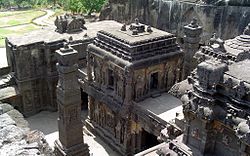 The view of the Kailash Temple from the top. The photo is taken at the cave temples clusters of Ellora, Maharastra, India.
The view of the Kailash Temple from the top. The photo is taken at the cave temples clusters of Ellora, Maharastra, India.
The Rashtrakutas who ruled the deccan from Manyakheta, Gulbarga district, Karnataka in the period AD 753 – 973 built some of the finest Dravidian monuments at Ellora (the Kailasanatha temple), in the rock cut architecture idiom. Some other fine monuments are the Jaina Narayana temple at Pattadakal and the Navalinga temples at Kuknur in Karnataka.
The Rashtrakutas contributed much to the culture of the Deccan. The Rashtrakuta contributions to art and architecture are reflected in the splendid rock-cut shrines at Ellora and Elephanta, situated in present day Maharashtra. It is said that they altogether constructed 34 rock-cut shrines, but most extensive and sumptuous of them all is the Kailasanatha temple at Ellora. The temple is a splendid achievement of Dravidian art. The walls of the temple have marvellous sculptures from Hindu mythology including Ravana, Shiva and Parvathi while the ceilings have paintings.
The project was commissioned by King Krishna I after the Rashtrakuta rule had spread into South India from the Deccan. The architectural style used was dravidian. It does not contain any of the Shikharas common to the Nagara style and was built on the same lines as the Virupaksha temple at Pattadakal in Karnataka.[8]
Western Chalukyas
Main article: Western Chalukya architectureThe Western Chalukyas also called the Kalyani Chalukyas or Later Chalukyas ruled the deccan from AD 973 – 1180 from their capital Kalyani in modern Karnataka and further refined the Chalukyan style, called the Western Chalukya architecture. Over 50 temples exist in the Krishna River-Tungabhadra doab in central Karnataka. The Kasi Vishveshvara at Lakkundi, Mallikarjuna at Kuruvatii, Kalleshwara temple at Bagali and Mahadeva at Itagi are the finest examples produced by the Later Chalukya architects.
The reign of Western Chalukya dynasty was an important period in the development of architecture in the deccan. Their architectural developments acted as a conceptual link between the Badami Chalukya Architecture of the 8th century and the Hoysala architecture popularised in the 13th century.[9][10] The art of Western Chalukyas is sometimes called the "Gadag style" after the number of ornate temples they built in the Tungabhadra – Krishna River doab region of present day Gadag district in Karnataka.[11] Their temple building reached its maturity and culmination in the 12th century, with over a hundred temples built across the deccan, more than half of them in present day Karnataka. Apart from temples they are also well known for ornate stepped wells (Pushkarni) which served as ritual bathing places, many of which are well preserved in Lakkundi. Their stepped well designs were later incorporated by the Hoysalas and the Vijayanagara empire in the coming centuries.
Hoysalas
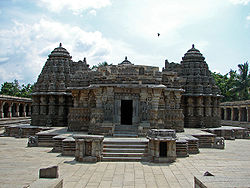 Symmetrical architecture on Jagati, Somanathapura, Karnataka
Symmetrical architecture on Jagati, Somanathapura, Karnataka Main article: Hoysala architecture
Main article: Hoysala architectureThe Hoysala kings ruled southern India during the period AD (1100–1343) from their capital Belur and later Halebidu in Karnataka and developed a unique idiom of architecture called the Hoysala architecture in Karnataka state. The finest examples of their architecture are the Chennakesava Temple in Belur, Hoysaleswara temple in Halebidu, and the Kesava Temple in Somanathapura.
The modern interest in the Hoysalas is due to their patronage of art and architecture rather than their military conquests. The brisk temple building throughout the kingdom was accomplished despite constant threats from the Pandyas to the south and the Seunas Yadavas to the north. Their architectural style, an offshoot of the Western Chalukya style,[12] shows distinct Dravidian influences. The Hoysala architecture style is described as Karnata Dravida as distinguished from the traditional Dravida,[13] and is considered an independent architectural tradition with many unique features.[14][15]
Vijayanagar
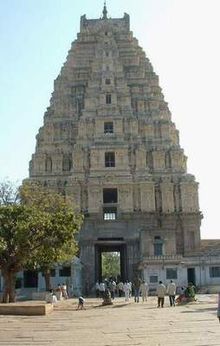 Virupaksha Temple at Hampi, Karnataka
Virupaksha Temple at Hampi, Karnataka Main article: Vijayanagar Architecture
Main article: Vijayanagar ArchitectureThe whole of South India was ruled by Vijayanagar Empire from AD (1343–1565), who built a number of temples and monuments in their hybrid style in their capital Vijayanagar in Karnataka. Their style was a combination of the styles developed in South India in the previous centuries. In addition, the Yali columns (pillar with charging horse), balustrades (parapets) and ornate pillared manatapa are their unique contribution. King Krishna Deva Raya and others built many famous temples all over South India in Vijayanagar Architecture style.
Vijayanagara architecture is a vibrant combination of the Chalukya, Hoysala, Pandya and Chola styles, idioms that prospered in previous centuries.[16][17] Its legacy of sculpture, architecture and painting influenced the development of the arts long after the empire came to an end. Its stylistic hallmark is the ornate pillared Kalyanamantapa (marriage hall), Vasanthamantapa (open pillared halls) and the Rayagopura (tower). Artisans used the locally available hard granite because of its durability since the kingdom was under constant threat of invasion. While the empire's monuments are spread over the whole of Southern India, nothing surpasses the vast open air theatre of monuments at its capital at Vijayanagara, a UNESCO World Heritage Site.[18]
In the 14th century the kings continued to build Vesara or Deccan style monuments but later incorporated dravida-style gopurams to meet their ritualistic needs. The Prasanna Virupaksha temple (underground temple) of Bukka Raya I and the Hazare Rama temple of Deva Raya I are examples of Deccan architecture.[19] The varied and intricate ornamentation of the pillars is a mark of their work.[20] At Hampi, though the Vitthala temple is the best example of their pillared Kalyanamantapa style, the Hazara Ramaswamy temple is a modest but perfectly finished example.[21] A visible aspect of their style is their return to the simplistic and serene art developed by the Chalukya dynasty.[22] A grand specimen of Vijayanagara art, the Vitthala temple, took several decades to complete during the reign of the Tuluva kings.[23]
External links
- Various component parts of a South Indian Chola temple explained
- Dravidian Temple Architecture
- varalaaru.com-tamil website
References
- ^ a b Fergusson, James (1997) [1910]. History of Indian and Eastern Architecture (3rd ed.). New Delhi: Low Price Publications. p. 309.
- ^ See Nilakanta Sastri, K.A. (1955). A History of South India, pp 421
- ^ Nagasamy R, Gangaikondacholapuram (1970)
- ^ The bronze image of nataraja at the Nagesvara Temple in Kumbakonam is the largest image known.
- ^ Over 125 temples exist in Aihole alone, Michael D. Gunther, 2002. "Monuments of India". http://www.art-and-archaeology.com/india/india.html. Retrieved 2006-11-10.
- ^ Arthikaje, Mangalore. "History of Karnataka – Chalukyas of Badami". 1998-00 OurKarnataka.Com,Inc. http://www.ourkarnataka.com/history.htm. Retrieved 2006-11-10.
- ^ The Badami Chalukya introduced in the western Deccan a glorious chapter alike in heroism in battle and cultural magnificence in peace said art critic K.V. Sounderrajan. They have influenced the architecture in Vengi and Gujarat- Dr. Suryanath U. Kamath (2001), A Concise History of Karnataka from pre-historic times to the present, Jupiter books, MCC (Reprinted 2002), p68
- ^ Takeo Kamiya. "Architecture of the Indian Subcontinent, 20 September 1996". Gerard da Cunha-Architecture Autonomous, Bardez, Goa, India. http://www.indoarch.org/. Retrieved 2006-11-10.
- ^ An important period in the development of Indian art (Kamath 2001, p115)
- ^ Arthikaje. "History of Karnataka – Chalukyas of Kalyani". 1998–2000 OurKarnataka.Com, Inc. http://www.ourkarnataka.com/history.htm. Retrieved 2006-11-10.
- ^ Kannikeswaran. "Temples of Karnataka, Kalyani Chalukyan temples". webmaster@templenet.com,1996–2006. http://www.templenet.com/Karnataka/kalyani_chalukya.html. Retrieved 2006-12-16.
- ^ James Fergusson and Henry Cousens write that the Hoysala style has many features in common with that of the Western Chalukya, Arthikaje, Mangalore. "History of Karnataka-Religion, Literature, Art and Architecture in Hoysala Empire". 1998–2000 OurKarnataka.Com, Inc. http://www.ourkarnataka.com/history.htm. Retrieved 2006-11-17.
- ^ Adam Hardy. "Indian Temple Architecture: Form and Transformation-The Karnata Dravida Tradition 7th to 13th Centuries, 1995". Vedams Books from India, Vedams eBooks (P) Ltd. https://www.vedamsbooks.com/no10217.htm. Retrieved 2006-11-17.
- ^ Percy Brown writes that the Hoysala style has negligible influences on the Indo-Aryan style and owing to its many independent features, qualifies as an independent school of architecture, Suryanath U. Kamath, A Concise History of Karnataka from pre-historic times to the present, 2001, Jupiter books, MCC, (Reprinted 2002), p134
- ^ Havell, R. Narasimhachar, M. Sheshadri and S. Settar also claim their style is an independent tradition, Arthikaje, Mangalore. "History of Karnataka-Religion, Literature, Art and Architecture in Hoysala Empire". 1998–2000 OurKarnataka.Com, Inc. http://www.ourkarnataka.com/history.htm. Retrieved 2006-11-17.
- ^ Art critic, Percy Brown calls Vijayanagar architecture a blossoming of Dravidian style, Kamath, p182
- ^ Arthikaje Literary Activity}
- ^ "So intimate are the rocks and the monuments they were used for make, it is was sometimes impossible to say where nature ended and art began" (Art critic Percy Brown, quoted in Hampi, A Travel Guide, p64)
- ^ Fritz & Mitchell, p9
- ^ Nilakanta Sastri about the importance of pillars in the Vijayanagar style in Kamath (2001), p183
- ^ "Drama in stone" wrote art critic Percy Brown, much of the beauty of Vijayanagara architecture came from their pillars and piers and the styles of sculpting (Hampi, A Travel Guide, p77)
- ^ About the sculptures in Vijayanagara style, see Kamath (2001), p184
- ^ Several monuments are categorised as Tuluva art (Fritz & Mitchell 2001, p9)
History of architecture Neolithic · Ancient Egyptian · Coptic · Chinese · Dravidian · Mayan · Mesopotamian · Classical · Mesoamerican · Achaemenid Persia · Ancient Greek · Roman · Incan · Sassanid · Byzantine · Islamic · Newari · Buddhist · Somali · Persian · Pre-Romanesque · Romanesque · Romano-Gothic · Gothic · Plateresque · Manueline · Hoysala · Vijayanagara · Western Chalukya · Renaissance · Ottoman · Mughal · Baroque · Biedermeier · Classicism · Neoclassical · Historicism · Gründerzeit · Gothic Revival · Neo-Renaissance · Neo-Baroque · Rationalism · Modernisme · Art Nouveau · Expressionism · Modern · PostmodernArchitecture of India Types Badami Chalukya · Bhumija · Dravidian · Harappan · Hoysala · Hindu temple · Latina · Kalinga · Mughal · Rock cut · Sekhari · Sharqi · Sikh · Vijayanagara · Western Chalukya · See also: Category:Indian architectureBy state · Andaman and Nicobar Islands · Andhra Pradesh · Arunachal Pradesh · Assam · Bihar · Chandigarh · Chhattisgarh · Dadra and Nagar Haveli · Daman and Diu · Goa · Gujarat · Haryana · Himachal Pradesh · Jammu and Kashmir · Jharkhand · Karnataka · Kerala · Lakshadweep · Madhya Pradesh · Maharashtra · Manipur · Meghalaya · Mizoram · Nagaland · Orissa · Pradesh · Puducherry · Punjab · Rajasthan · Sikkim · Tamil Nadu · Tripura · Uttar Pradesh · Uttarakhand · West BengalBy city Categories:- Architectural styles
- South India
- Indian architectural styles
- Indian architectural history
Wikimedia Foundation. 2010.

